-
1213
Description: Rectangle with curved shoulders and low arch joined with concave curves; fillet and ogee moulded edging; central Tudor royal shield surrounded by garter, with crown above and lion and dragon supporters; royal initials either side of crown.
Notes: On other castings of this fireback the initials are 'ER', the 'I' for James having been substituted here for the 'E' for Elizabeth but incorrectly retaining the Tudor shield. The garter motto includes ‘EQVI’ instead of ‘HONI’, making it meaningless; possibly ‘EQVI’ was a mis-transcription of ‘HONI’; the crown is distinctly continental in form.
Inscription: I R
Arms: Tudor royal - Edward VI or Elizabeth I
- Decoration tags:
- rectangular with round arch (shape)
- fillet and ogee (edging)
- whole carved pattern
- individual letters
- heraldic
- armorial
- royal
- text
Manufactured: in the early-17th century in England.
Current location: Prior's Hall, Durham Cathedral, Durham, County Durham, England.
- Attached to series:
- Jacobean royal armorial firebacks
- Garter error series
-
56
Description: Flattened arched rectangular shape; cavetto moulded edge all round; Stuart royal arms with lion and unicorn supporters, crown, garter and motto; CR initials placed separately outside supporters; date split either side of crown.
Notes: A much-copied variant with the additional initials, I T, above the date and on either side of the crown.
Copies of this fireback are known.
Inscription: I T / 1635 / C R / HONI SOIT QVI MAL Y PENSE / DIEV ET MON DROIT
Arms: English Stuart royal (Charles I )
- Decoration tags:
- rectangular with round arch (shape)
- cavetto (edging)
- whole carved pattern
- planklines
- armorial
- royal
- text
Manufactured: in 1635 in the Weald area of England.
Current location: Dyrham Park, Dyrham, Gloucestershire, England.
Museum number: 453291 (part of the National Trust museum group)
Citation: Lloyd, N., 1925, 'Domestic Ironwork I', Architectural Review, 58, pp. 58-67.
- Attached to series:
- Carolean royal armorial firebacks
- Stuart royal armorial firebacks
-
275
Description: Arched rectangular central panel with indented arch at bottom; bead within double fillet edging; shield, helm, crest and supporters of Bruce, of Duffryn, Glamorgan; 'Fuimus' inscription above crest; motto in rectangular panel below arms; arched rectangular border with fillet edging; scrolled tendril decoration all round, except at centre bottom where is inserted crowned 'A' between halves of date; mirrored scrolls above shoulders of plate.
Notes: A modern plate in traditional style; the arms are of Henry Campbell Bruce (1851-1929), the second baron, who succeeded to the title in 1895.
Copies of this fireback are known.
Inscription: FVIMVS [We have been] / OFNER NA OFNE ANGAV [Fear him who does not fear death] / 19 A 06
Arms: Henry Campbell Bruce, 2nd Baron Aberdare
- Decoration tags:
- rectangular with round arch (shape)
- fillet (edging)
- whole carved pattern
- armorial
- text
Manufactured: in 1906 in England.
Current location: Tottington Manor, Edburton, West Sussex, England.
- Attached to series:
- British 'Dutch' style firebacks
- Personal armorial firebacks
-
282
Description: Arched rectangle; cavetto moulded edging; garter enclosing Stuart royal arms, crown, crowned lion and unicorn supporters and motto; initials in top corners.
Notes: The crown is not typically English in form, suggesting that the patternmaker may have been of foreign extraction.
Copies of this fireback are known.
Inscription: C R / [Garter motto - illeg.]
Arms: English Stuart royal
- Decoration tags:
- rectangular with round arch (shape)
- cavetto (edging)
- whole carved pattern
- armorial
- royal
- text
Manufactured: in the mid- to late-17th century in England.
Current location: Chequers, Ellesborough, Buckinghamshire, England.
-
967
Description: Arched rectangular shape; twisted rope edging; central shield, garter, supporters, motto and crown; date in arch; initials 'I R' (Iacobus Rex) separated by crown; initials 'R T' separated by supporters, and level with other initials; fleur-de-lys stamp repeated 16 times, one each side of date, two on each shoulder of plate, five down each side.
Notes: A naively carved armorial of James I (VI of Scotland). The initials 'RT' are likely to be those of the person who commissioned the fireback. A fireback with an identical armorial, supporters and royal initials, dated 1633, was recorded by Alfred Watkins at Fawley Court, Brockhampton, Herefordshire, before 1918 (but now no longer in situ).
Inscription: 1611 / R I R T / HONY SOIT QVI MAL Y PENSE / [motto illegible]
Arms: English Stuart royal
- Decoration tags:
- rectangular with round arch (shape)
- rope (edging)
- whole carved pattern
- individual letters
- individual numbers
- heraldic
- armorial
- text
Manufactured: in 1611 in England.
Current location: 48 Scotland Street, Ellesmere, Shropshire, England.
- Attached to series:
- Stuart royal armorial firebacks
-
1179
Description: Arched rectangular shape; astragal and fillet edging (top and sides); central shield with arms of Eton College, surmounted by a small tilting shield of the pre-1603 Royal arms of England (France modern quartering England) aslant beneath a crown; to each side a spray of lilies; below, a scroll bearing the motto - Esto Perpetua; bottom left the date MCMXCII; bottom right, a panel bearing the phrase C of A and [?].
Notes: The motto Esto Perpetua means Let it be perpetual. Fireback designed by and made for Martin, Lord Charteris of Armisfield, who was Provost of Eton College 1978-91. One of a set of two cast for the college.
Copies of this fireback are known.
Inscription: ESTO PERPETUA / MCMXCII C of A [Charteris of Armisfield]
Arms: Eton College
- Decoration tags:
- rectangular with round arch (shape)
- astragal & fillet (edging)
- whole carved pattern
- heraldic
- armorial
- text
- plants
Manufactured: in 1992 in England.
Current location: Eton College, Eton, Berkshire, England.
Museum number: FDA-A.238:2-2013 (part of the Eton College museum group)
- Attached to series:
- Martin Charteris firebacks
- Corporate firebacks
-
288
Description: Arched rectangular with plain edges; arched rectangular inset with cavetto edging and armorial design in low relief: circular garter enclosing an ornate Tudor royal shield, surmounted by a crown; date inside top of arch; initials inside top corners of rectangle; a rose in each bottom corner of rectangle; inscription in a separate rectangular panel below, split by garter buckle.
Notes: The earliest dated fireback in the English style. Molland was a Devon manor belonging to the Courtenay family. Noted as having been at Wells Deanery, Somerset, in 1845; a variant without the motto, the existence of which was noted in 1840, was illustrated by Llewellin (1863). The west country source for both of these firebacks offers the possibility of an origin in those parts.
Copies of this fireback are known.
Inscription: 1553 / E R / HONV SOIT QVY MALE V PENCE / MOL LAND
Arms: Tudor royal - Edward VI
- Decoration tags:
- rectangular with round arch (shape)
- none (edging)
- whole carved pattern
- armorial
- royal
- text
Manufactured: in 1553 .
Current location: Davington Priory, Priory Road, Faversham, Kent, England.
Citation: Collier, C. V., 1897, 'Coats of Arms in Kent Churches', Archaeologia Cantiana, 22, pp. 190-1.
- Attached to series:
- Edwardian royal armorial firebacks
- Tudor royal armorial firebacks
-
941
Description: Arched rectangular shape; scalloping within wide fillet edging; shield, knight's helm, crest and mantling; date split either side of armorial.
Notes: The arms are of Kyrle (vert, a chevron between three fleurs de lys or; crest: on a mount vert a hedgehog or) of Much Marcle, Herefordshire, quartered with Abrahall (azure three hedgehogs or; the fess appears to be erroneous) and Warnecombe (sable, on a fess dancetty argent between three bezants each charged with an escallop of the field as many lions rampant argent armed and langued gules). The second part of the date appears to have been altered by hand for the present casting as the style of lettering for the final two numerals is crude compared with the first two. Sir John Kyrle may have operated the iron furnace at Whitchurch, between Monmouth and Ross on Wye; the style of the carving is the same as on two other firebacks in the same county. It is apparent, from another example, that this fireback has either been broken and repaired, or deliberately reduced in height. Originally the mantling of the helm extended further down, ending in tassels on each side, making the height of the fireback approximately equal to its width. An early photograph of the Fawley fireback, taken by Alfred Watkins, the Herefordshire antiquarian, shows the division of the two parts more clearly (Herefordshire Record Office, AW339b). A copy of the original, un-reduced fireback has been noted with the date 1685 in the distinctive numerals seen on firebacks from Flaxley Furnace, Gloucestershire.
Copies of this fireback are known.
Inscription: 16 20
Arms: Kyrle quartering Abrahall and Warnecombe
- Decoration tags:
- rectangular with round arch (shape)
- fillet with scalloping (edging)
- whole carved pattern
- individual numbers
- armorial
- text
Manufactured: in 1620 possibly at Whitchurch Furnace in the Herefordshire area of England.
Current location: in private hands, Fawley, Herefordshire, England.
- Attached to series:
- Personal armorial firebacks
- Herefordshire armorial series
-
68
Description: Canted rectangle; ovolo edging (top and sides); symmetrically arranged, initials separated by overpressed, fillet edged stamp bearing letters WF surmounted by a bent arm holding a battleaxe issuing from a chapeau; beneath are two shields bearing the arms of Fowle.
Notes: The shield and crest stamps relate to William Fowle (1568-1634) and are those used on iron grave slabs in Wadhurst and Frant churches and in Maidstone museum, as well as on other firebacks. The initials have not been identified. The fireback was formerly in Riverhall, Wadhurst, built by William Fowle. Another casting with the same set of initials, but in a slightly different arrangement, has been noted (no. 1077), and Christy (1908 p.386) reported on another with slots for two firedogs.
Inscription: EC DT / WF
Arms: William Fowle, of Frant and Wadhurst
- Decoration tags:
- rectangular with canted top corners (shape)
- astragal (edging)
- carved stamps
- individual letters
- heraldic
- armorial
- text
Manufactured: in the early- to mid-17th century probably at Riverhall Furnace, Wadhurst in the Weald area of England.
Current location: in private hands, Frant, East Sussex, England.
- Attached to series:
- Fowle series
-
297
Description: Arched rectangular shape; wide fillet edging with alternate bead and pellet on top and sides, the pellets rotated over the arch where they are separated in triplets by blocks; shield, helm, crest and mantling of Saunderson, with a strapwork compartment at the bottom; initials split by wreath; date split by crest.
Notes: The arms are probably those of Thomas Saunderson of Gainsborough (c.1568- before 1642).
Copies of this fireback are known.
Inscription: 16 19 / T S
Arms: Thomas Saunderson of Gainsborough
- Decoration tags:
- rectangular with round arch (shape)
- fillet (edging)
- whole carved pattern
- armorial
Manufactured: in 1619 in England.
Current location: Museum of Lincolnshire Life, Burton Road, Lincoln, Lincolnshire, England.
(part of the Lincolnshire County Council museum group)
- Attached to series:
- Personal armorial firebacks
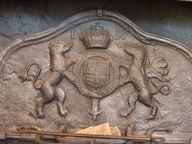

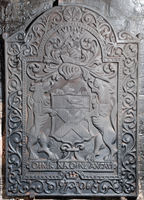
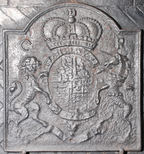

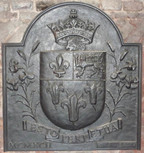
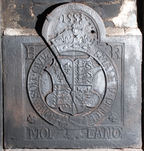

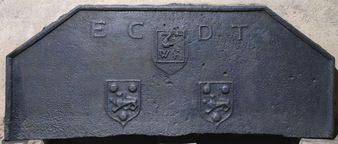
.jpg)